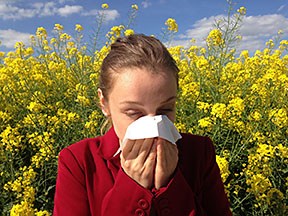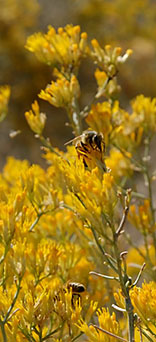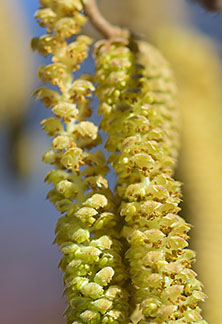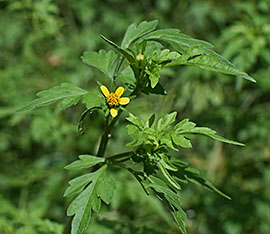PAGE NAVIGATION
COMPLEMENTARY TREATMENTS
WESTERN INTERPRETATION
According to conservative estimates, more than one in five Americans has allergies, and the number rises every year. Although the vast majority of allergy sufferers consider their symptoms a major annoyance rather than a chronic disease, allergic reactions to insect venom, antibiotics, and other allergens take the lives of thousands of Americans every year.
Allergies are defined as an exaggerated immune response to an otherwise nonirritating or mildly irritating substance such as pollen, dust, mold, or insect venom, or to a “man-made allergen” such as synthetic fabric, various building materials, and food additives. The most common allergy is hay fever, an inflammatory reaction caused by hypersensitivities to pollens and mold spores. Symptoms of hay fever include sneezing, itchy and watery eyes, runny nose, and burning sensations in the throat and palate. Complications include lack of sleep, loss of appetite, inflammation of the ears, sinus, throat, and bronchi, asthma, and general immune system depletion.
In this section we focus on common allergies and food sensitivities.
WESTERN TREATMENT

Numerous prescription and over-the-counter drugs are available to provide symptomatic relief, including antihistamines, decongestants, and immuno-suppressive corticosteroids. The side effects of antihistamines and decongestants- drowsiness, dizziness, fatigue, insomnia, digestive problems, mental confusion, and irritability-are relatively common and can be serious. Most doctors today offer non-sedating antihistamines and steroid sprays to avoid these side effects; however, antihistamines also create tolerance in regular users, so that you have to take ever higher doses of the drug in order to achieve the desired effect.
Side effects associated with oral corticosteroids include swelling of the face (“moon face” or swollen cheeks), abdominal bloating, weight gain, increased vulnerability to infection, disturbances of the menstrual cycle, heartburn, fatigue, insomnia, and mood swings with anxiety and! or depression. Topical steroidal creams can have significant side effects as well, including thinning of the skin, a condition that can be permanent and lead to easy bruising; permanent lightening of the skin; and suppression of adrenal gland functioning, especially in children. Long-term use of inhaled steroidal sprays may cause thrush (yeast overgrowth) in the respiratory system; a deterioration of the mucosal lining of the airways, particularly the vocal cords; and systemic absorption of these drugs, increasing the possibility of the side affects associated with oral corticosteroids. With steroidal nasal sprays, most of these side effects can be minimized or eliminated.
The fourth step in treatment is desensitization. This is the treatment of choice for allergic reactions to bee stings or penicillin because no drugs are used and a complete cure is possible. The patient receives a series of gradually increasing amounts of the allergic substance until the system becomes desensitized and therefore less reactive to the offending allergen. Desensitization can be a life-saving procedure for anyone who has experienced anaphylactic shock, a serious, sometimes life-threatening state of shock brought about by hypersensitivity to drugs, foreign proteins, or insect venom
Treatment for food allergies and sensitivities generally consists of eliminating suspected allergy-causing foods from the diet. Food allergies can also be detected through blood tests, diagnostic skin tests, or the Elimination Provocation Diet, in which various foods are eliminated from the diet and reintroduced with careful attention paid to recurring symptoms.
 TRADITIONAL CHINESE INTERPRETATION
TRADITIONAL CHINESE INTERPRETATION
The Chinese believe that hay fever and other allergies are caused by two related factors:
- A deficiency in Lung (Metal) energy. The Lungs synthesize wei chi (the body’s defensive energy) and rule the quality, quantity, and circulation of wei chi. When Lung chi is deficient, the wei chi weakens and begins to react inappropriately to external irritants (allergens).
- Constrained Liver chi. When the Liver is exhausted by stress, inadequate diet, insufficient exercise, lack of sleep, or emotional strain, toxins build up in the blood, and the body’s vital energy (chi) slows down. “Constrained Liver chi” inevitably leads to a state of chronic irritability and emotional over-reactivity, which contributes to allergic reactions and symptoms. A vicious cycle ensues as anxiety, fear, anger, and overexcitement create additional stress on an already overstressed system.
In the case of food allergies, the Liver deficiency is joined by Spleen/Pancreas and Stomach imbalances, which contribute to the inadequate digestion of proteins. (Other factors contributing to incomplete digestion include low hydrochloric acid levels, insufficient pancreatic enzymes or bile, and improper chewing of food.) These partially digested proteins (sometimes called “renegade” proteins) are absorbed through the intestinal walls into the body fluids, which carry them to various sites throughout the body, causing the immune system to overreact and resulting in such diverse and seemingly unrelated symptoms as muscle aches, joint pain, chronic sinusitis, itchy, irritated eyes, skin disorders, headaches, indigestion, and multiple food sensitivities.
Treatment is aimed at strengthening and nourishing the Lung energies and supporting the Liver to help restore the free flow of energy and blood. Treatments for food allergies or sensitivities with digestive symptoms focus on supporting the Spleen/Pancreas by paying special attention to diet, reducing or eliminating refined carbohydrates and refined sugars, and using various herbs to restore balance.
COMPLEMENTARY TREATMENTS
Diet

Whether or not a given allergy has a direct dietary cause, you can safely assume that your diet-specifically, the fast-food, processed-and-refined-food, high-sugar, and high-fat diet that most Americans enjoy-plays a significant role in all allergic reactions. If you suffer from allergies of any kind, if you have a family history of allergies, or if you simply want to clean up your diet to strengthen your immune system, follow these general dietary guidelines:
- Eliminate or drastically reduce your consumption of dairy products, the number-one food allergen; if you use dairy products, always use the nonfat varieties, and limit your consumption to no more than two or three servings a week.
- Eliminate or drastically reduce your intake of wheat products (cereals, gravies, breads), the number-two food allergen. Substitute nonallergenic grains like white and brown rice. If you use wheat products, limit your consumption to one serving daily, and use whole (unprocessed and unrefined) forms of the grain (whole-grain cereals, breads, pastas). To avoid overconsumption of one particular grain, try adding other grains to your diet such as millet, buckwheat, quinoa, and amaranth (actually a seed but used as a grain).
- Reduce your consumption of meats, which are high in saturated fats and have been treated with numerous chemical additives, including estrogen and antibiotics. If possible, buy organic (nonchemically treated) meat and dairy products. If you can’t afford to buy organic products (which are significantly more expensive than nonorganic products), substitute protein-rich grains, beans, nuts, seeds, and vegetables (the standard vegetarian fare) for red and white meat.
- Eat “whole” foods-foods that have not been processed, refined, treated with chemical preservatives, or loaded with artificial ingredients to enhance flavor or retard spoilage-whenever possible. Whole foods include whole-grain bread and pasta, fresh fruits and vegetables, beans, legumes, organic meats, nuts, and seeds (raw or baked without salt, hydrogenated oils, or additives).
- Eat plenty of vegetables and fruit, but watch out for corn, tomatoes, and oranges, which can trigger food allergies or sensitivitiesIf you have a sensitivity to yeast or have yeast infections, avoid baked goods, sugar, vinegar, mayonnaise made with vinegar, fermented foods, and “moldy” foods (mushrooms, alcohol, cheeses, dried fruits).
- Diversify your diet, choosing foods from many different food groups to help control preexisting food allergies and sensitivities and to prevent the formation of new allergies. When a particular food allergen is repeatedly present in the body, the immune system is on constant alert. Rotating different foods and food groups gives the immune system a much-needed rest.
- Pay special attention to your food cravings; many physicians and naturopaths who specialize in food allergies believe that food cravings are actually symptoms of an allergic reaction to a particular food or foods.
- If you continue to feel drained of energy, irritable, and hypersensitive, or if you experience any of the following symptoms-fatigue, headaches, mood swings, depression, muscle aches and pains, muscle weakness, digestive problems (gas, bloating, bowel irregularities), arthritis, chronic sore throat, chronic sinusitis, skin problems (hives, eczema, psoriasis), hay fever, or asthma-consider having your blood tested for allergic sensitivities or try the Elimination Provocation Diet.
- Drink eight to ten 8-ounce glasses of fresh, filtered water every day.
Nutritional Supplements
Vitamin C: This vitamin is essential for a strong immune system and a powerful ally if you have allergies. In large doses vitamin C works as a natural antihistamine, relieving many of the symptoms associated with hay fever and food allergies. Take 1,000 mg. every one or two hours, up to 12,000 mg. (12 grams). If you experience loose bowels or diarrhea, cut back on the dosage until the symptoms subside.
- Quercetin: This bioflavonoid reduces inflammatory and histamine levels, providing significant relief for allergy sufferers. Take 250 mg. thirty minutes before eating, two to three times daily. Quercetin is often combined with a digestive enzyme such as bromelain, which increases its effectiveness. Be sure to look for a formula that includes bromelain or other pancreatic enzymes.
- B-50 or B-100 complex: The B vitamins provide the spark for numerous physiological and neurological processes, helping your body cope with everyday stress as well as the additional strain of chronic illness. Take a B-so or B-lOO complex vitamin daily.
- Vitamin A: This vitamin improves the immune system’s antibody response and has a powerful effect on the wei chi, strengthening and supporting virtually every cell in the immune system. You can substitute beta-carotene, but vitamin A is slightly more effective for allergies. Take 20,000 to 25,000 J.D. daily.
- Vitamin E: This vitamin supports the mucous membranes and promotes healing; take 400 to 800 J.D. daily.
- Gamma linoleic acid (GLA): This essential fatty acid works as a natural anti-inflammatory agent, inhibiting the release of inflammatory prostaglandins and reducing the body’s allergic response. Oil of evening primrose, borage seed oil, and black currant seed oil are all excellent sources of GLA. Take three to four 500-mg. capsules (each capsule contains 35 to 40 mg. GLA), for a total of 1,500-2,000 mg. daily.
- Hydrochloric acid tablets: These tablets support the stomach acids to help you thoroughly metabolize your food, thereby reducing the “renegade” proteins that result from incomplete digestion and that contribute to allergic reactions. If you are prone to ulcers or hyperacidity, consult with your doctor or health care professional before taking this supplement. Take one 5-to-1O-grain tablet with each meal. (Some people with low stomach acid may require significantly more than this amount; check with your health care provider if you suspect your problems might be related to low levels of hydrochloric acid.)
- Fiber: Fiber promotes regular bowel movements and helps propel the digestive contents through the intestines. When undigested food particles become bound or tied to fiber, the digestive process works more efficiently to move food quickly through the system and thereby reduce the risk of “renegade” proteins (undigested protein particles) leaking into body fluids and creating allergic reactions.
Exercise
If you have allergies, try to exercise regularly to help the Liver maintain a free flow of energy and blood, thus preventing stagnation and “stuckness.” Don’t go overboard, however; when Kidney and Spleen energies are deficient, as they often are in allergy victims, strenuous exercise can further drain these vital reserves. Try to exercise at least twenty to thirty minutes every day; brisk walking, tai chi, yoga, or swimming are excellent choices. If you don’t suffer from symptoms of deficient energy-lethargy, heavy limbs, aching muscles or joints-you can safely engage in more strenuous exercises. Start slow, and don’t push yourself.
Herbal Allies
For allergies caused by pollens, mold spores, or animal dander, an effective formula would include the following herbs:
- Licorice (Glycyrrhiza glabra): An incredibly versatile herb, licorice’s expectorant actions work to eliminate excess mucus from the lungs and bronchial system, while its natural anti-inflammatory effects help to subdue the fires of allergies and such symptoms as inflamed nasal passages or sinuses; red, inflamed, or irritated eyes; and skin reactions with burning and itching. Licorice also has a balancing effect on the adrenal glands, easing the effects of stress on all body systems.
- Dandelion root (Taraxacum officinalis): This herb supports the Liver, helps the digestive system work more efficiently, promotes a healthy flow of bile, and generally works to “unconstrain” constrained Liver chi.
- Echinacea (Echinacea angustifolium): This herb provides a powerful boost to the immune system.
- Osha root (Ligusticum parten): This potent antimicrobial herb works to prevent infections and relieve the symptoms associated with allergies. Although osha root was used extensively and with great success by Native American tribes in the mountains and high deserts of the United States, it was never incorporated into the European herbal tradition, and even today the wonders of this amazing plant remain relatively unknown. If you can’t find osha in your health food store, a good substitute is goldenseal, another antimicrobial herb with powerful effects on Liver functions.
You can have these five herbs mixed in equal parts by a qualified herbalist, or you can buy a premixed allergy formula that includes several of these popular herbs at your health food store. A simpler formula, wonderful for preventing allergies and/or treating allergic symptoms, consists of one part ephedra to two parts licorice and two parts dandelion root.
Dosage: If you purchase your herbs in a health food store (either in tincture form or, as dried herbs, in capsule or pill form), follow the dosage instructions on the label. Because herbs in dried form tend to lose their potency rather quickly, be sure to check the label for the expiration date.
Complementary Herbal Formulations:

- Integral Health Apothecary’s AllergEase Formula utilizes the traditional Chinese remedy for constrained Liver, which mitigates allergy symptoms, as well as Western herbs to specifically address allergic symptoms. Ingredients: Nettle leaves, Schizonepeta aerial parts, Bupleurum root, Chinese Peony root, Dong Quai root, Poria sclerotium, Magnolia bark, Chinese Mint aerial parts, Dandelion root, fresh Cleavers aerial parts, fresh Osha root, Ginger rhizome.
- Bupleurum and Peony Formula (“Relaxed Wanderer Formula”): This is considered the archetypal remedy for constrained Liver chi, which interferes with proper digestion and can lead to many allergies, including food allergies and sensitivities.
For food sensitivities, the following remedies work well together:
- Ginseng and Astragalus Combination (“Support the Center, Benefit Energy Formula”): Considered the archetypal Spleen tonic, these pills support Kidney and Spleen energies. Ginseng and astragalus are the Emperor herbs, supported by eight attending herbs that work together to aid digestion, support the Kidneys, and balance Liver and Spleen energies. This quick and effective formula relieves such symptoms as abdominal bloating, gas, pain, and irregular bowel habits.
These complementary herbal formulations are extremely gentle and can be safely combined with any of the listed herbs. If you need help choosing the most effective formula or combination of herbs for your symptoms, consult an experienced herbalist.
Acupoints
LIVER 3 (“Great Rushing”): This point helps the Liver in its job of circulating and distributing blood and chi throughout the body. It is often used when Liver energy is constrained or deficient. It also helps to expel “Wind” conditions caused by an imbalance in Liver chi, including tremors, muscle twitches, migrating pains in the joints or muscles, dizziness, and headaches. Location: Liver 3 is located on the upper part of the foot in the depression in the webbing between the big toe and the second toe.
- LARGE INTESTINE 4 (“Great Eliminator”): This point is used for draining or dispersing energy “stuck” in the upper part of the body, especially the head and neck areas, and for relieving headaches, irritated or swollen eyes, sinus congestion, stuffy nose, sore throat, swollen glands, and neck or shoulder tightness with pain and spasm. It is also used to soothe the digestive system, alleviating gas, diarrhea, and constipation. Location: Large Intestine 4 is located on the top of the hand, in the webbing between the thumb and index finger.
Questions to Ask Yourself

The following questions will help you understand and appreciate the role your emotions play in your allergic sensitivities and guide you to potential solutions. Focus on one or two questions that relate most directly to your particular situation.
- How can I bring more balance into my life and respond, rather than simply react, to situations that arise?
- How do I suppress my emotions?
- How are my allergies working for me? What are they allowing me to do? What are they preventing me from doing?
Allergies are often associated with Lung (Metal) imbalances, which makes sense since Metal energy rules the Lungs, Skin, bronchial passages, and sinuses. The Chinese believe grief, the emotion associated with Metal, can cause or exacerbate allergic reactions. If unresolved or unexpressed grief is a factor in your life, ask yourself:
- What am I grieving for?
- What do I need to let go of before I can move ahead with my life, my goals, my relationships?
Liver (Wood) imbalances are also associated with allergies. If Wood is deficient, friction builds up in the system, and you become more irritable and hyper-reactive. Stifled creativity (a symptom of “stuck” Wood energy) is also connected with allergies. Ask yourself:
- What irritates me these days?
- Why do I feel frustrated or discontented?
- Is something interfering with my ability to move forward and express myself creatively?


 Vitamin C: This vitamin is essential for a strong immune system and a powerful ally if you have allergies. In large doses vitamin C works as a natural antihistamine, relieving many of the symptoms associated with hay fever and food allergies. Take 1,000 mg. every one or two hours, up to 12,000 mg. (12 grams). If you experience loose bowels or diarrhea, cut back on the dosage until the symptoms subside.
Vitamin C: This vitamin is essential for a strong immune system and a powerful ally if you have allergies. In large doses vitamin C works as a natural antihistamine, relieving many of the symptoms associated with hay fever and food allergies. Take 1,000 mg. every one or two hours, up to 12,000 mg. (12 grams). If you experience loose bowels or diarrhea, cut back on the dosage until the symptoms subside.
 LIVER 3 (“Great Rushing”): This point helps the Liver in its job of circulating and distributing blood and chi throughout the body. It is often used when Liver energy is constrained or deficient. It also helps to expel “Wind” conditions caused by an imbalance in Liver chi, including tremors, muscle twitches, migrating pains in the joints or muscles, dizziness, and headaches. Location: Liver 3 is located on the upper part of the foot in the depression in the webbing between the big toe and the second toe.
LIVER 3 (“Great Rushing”): This point helps the Liver in its job of circulating and distributing blood and chi throughout the body. It is often used when Liver energy is constrained or deficient. It also helps to expel “Wind” conditions caused by an imbalance in Liver chi, including tremors, muscle twitches, migrating pains in the joints or muscles, dizziness, and headaches. Location: Liver 3 is located on the upper part of the foot in the depression in the webbing between the big toe and the second toe.